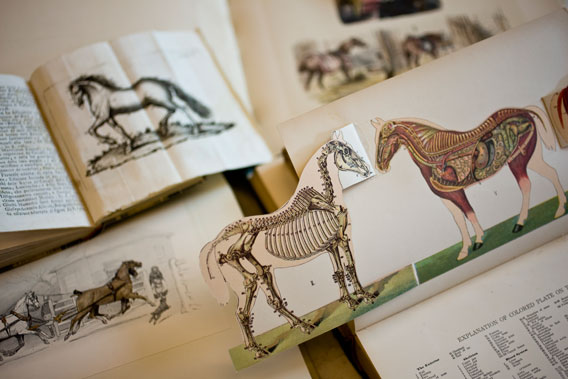Horse Tales
Period equine books find a home in Grafton-and in cyberspace
By Leslie Macmillan
The Webster Family Library at the Cummings School has more than doubled its holdings through a simple act of a man who genuinely loved horses. The library is now home to more than 7,000 equine books, a bequest from the late John A. Seaverns, who “fell in love with horses during a job he had cleaning out stables when he was 18,” says Alyssa Freden, who is helping to catalogue the collection.

With their hand-bound leather covers, rag pages and illustrations, the books in the new collection are a pleasure to leaf through. Photo: Melody Ko
Most of the books were published in the 19th and 20th centuries and cover every aspect of horsemanship, from racing, hunting, riding, breed histories and equestrian art to descriptions of horse-drawn carriages and farriers. The oldest dates back to 1571, and the most valuable is worth more than $10,000.
There are several rare treatises on horsemanship, including one from the 16th century, the Duke of Newcastle’s A General System of Horsemanship (1743). With their hand-bound leather covers, rag pages, woodblock illustrations and titles like Romance of the Road, the books are a pleasure to leaf through in this digital age.
It is an interesting irony that these equine classics are moving to a very high-tech home—cyberspace—as the library undertakes the massive project of digitizing the collection. Through an agreement between the Boston Library Consortium and the Open Content Alliance, the books no longer subject to copyright laws will be hosted by the Internet Archive and available to be indexed by any search engine.
“Digitization makes the collection more valuable,” says Margret Branschofsky, director of library services and information technology at the Cummings School.
Freden says she’s already cataloged more than 2,040 of the books. She’s also blogging about her cataloguing adventures. A recent entry: What do show jumping and Bullmastiffs have to do with one another? (Answer: nothing, except they were the topics of the last two books she read from the collection.) For Freden, the cataloguing job was “a dream come true,” she says. In addition to being a librarian, she is an avid rider who teaches dressage.
So far, the most downloaded books are about English country roads, says Freden. At 255 downloads, the hottest book, published in 1922, is The Brighton Road: The Classic Highway to the South. In it, author Charles George Harper describes and illustrates the riding path south of London.
Betsy Like, the educational services librarian, still recalls receiving the books shortly after Christmas in 2002. “There were 230 boxes of books. We tried to unpack them as quickly as we could. For three of us, that’s all we did for two weeks.”
The cataloguing and digitizing is expected to take up to two years. Every week, 40 volumes are shipped to the Boston Public Library, where they are manually scanned, page by page.
The painstaking work is beginning to pay off, in the form of e-mails, downloads and web hits from around the world. The librarians recently received an e-mail from a man in England, who thanked them for putting the books online: “They will be of the greatest help in my research,” he wrote. “It was a wonderful present on what otherwise has been a wasted day.”
The collection is available to anyone who wishes to peruse the real volumes, carefully arranged on custom-built shelves in the Webster Library.
However, the librarians know that they will reach their greatest audience in cyberspace. “The real value of putting them online,” Branschofsky says, “is so the world can see them.”Learn more at the collection’s website.
Leslie Macmillan can be reached at leslie.macmillan@tufts.edu.


